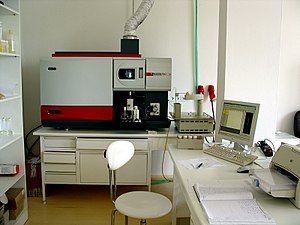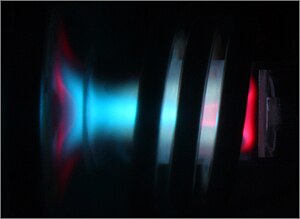Chemical Sciences: A Manual for CSIR-UGC National Eligibility Test for Lectureship and JRF/Inductively coupled plasma atomic emission spectroscopy
| This page was imported and needs to be de-wikified. Books should use wikilinks rather sparsely, and only to reference technical or esoteric terms that are critical to understanding the content. Most if not all wikilinks should simply be removed. Please remove {{dewikify}} after the page is dewikified. |

Inductively coupled plasma atomic emission spectroscopy (ICP-AES), also referred to as inductively coupled plasma optical emission spectrometry (ICP-OES), is an analytical technique used for the detection of trace metals. It is a type of emission spectroscopy that uses the inductively coupled plasma to produce excited atoms and ions that emit electromagnetic radiation at wavelengths characteristic of a particular element.[1][2] The intensity of this emission is indicative of the concentration of the element within the sample.
Mechanism[edit | edit source]

The ICP-AES is composed of two parts: the ICP and the optical spectrometer. The ICP torch consists of 3 concentric quartz glass tubes. The output or "work" coil of the radio frequency (RF) generator surrounds part of this quartz torch. Argon gas is typically used to create the plasma.
When the torch is turned on, an intense electromagnetic field is created within the coil by the high power radio frequency signal flowing in the coil. This RF signal is created by the RF generator which is, effectively, a high power radio transmitter driving the "work coil" the same way a typical radio transmitter drives a transmitting antenna. The argon gas flowing through the torch is ignited with a Tesla unit that creates a brief discharge arc through the argon flow to initiate the ionization process. Once the plasma is "ignited", the Tesla unit is turned off.
The argon gas is ionized in the intense electromagnetic field and flows in a particular rotationally symmetrical pattern towards the magnetic field of the RF coil. A stable, high temperature plasma of about 7000 K is then generated as the result of the inelastic collisions created between the neutral argon atoms and the charged particles.
A peristaltic pump delivers an aqueous or organic sample into a nebulizer where it is atomized and introduced directly inside the plasma flame. The sample immediately collides with the electrons and other charged ions in the plasma and is broken down into charged ions. The various molecules break up into their respective atoms which then lose electrons and recombine repeatedly in the plasma, giving off radiation at the characteristic wavelengths of the elements involved.
In some designs, a shear gas, typically nitrogen or dry compressed air is used to 'cut' the plasma flame at a specific spot. One or two transfer lenses are then used to focus the emitted light on a diffraction grating where it is separated into its component wavelengths in the optical spectrometer. In other designs, the plasma impinges directly upon an optical interface which consists of an orifice from which a constant flow of argon emerges, deflecting the plasma and providing cooling while allowing the emitted light from the plasma to enter the optical chamber. Still other designs use optical fibers to convey some of the light to separate optical chambers.
Within the optical chamber(s), after the light is separated into its different wavelengths (colors), the light intensity is measured with a photomultiplier tube or tubes physically positioned to "view" the specific wavelength(s) for each element line involved, or, in more modern units, the separated colors fall upon an array of semiconductor photodetectors such as CCDs charge coupled devices. In units using these detector arrays, the intensities of all wavelengths (within the system's range) can be measured simultaneously, allowing the instrument to analyze for every element to which the unit is sensitive all at once. Thus, samples can be analyzed very quickly.
The intensity of each line is then compared to previously measured intensities of known concentrations of the elements, and their concentrations are then computed by extrapolation along the calibration lines.
In addition, special software generally corrects for interferences caused by the presence of different elements within a given sample matrix.
Applications[edit | edit source]
Examples of the application of ICP-AES include the determination of metals in wine,[3] arsenic in food,[4] and trace elements bound to proteins.[5]
ICP-OES is widely used in minerals processing to provide the data on grades of various streams, for the construction of mass balances.
In 2008, the technique was used at Liverpool University to demonstrate that a Chi-Rho amulet found in Shepton Mallet and previously believed to be among the earliest evidence of Christianity in England,[6] only dated to the nineteenth century.[7][8][9]
ICP-AES is often used for analysis of trace elements in soil, and it is for that reason it is often used in forensics to ascertain the origin of soil samples found at crime scenes or on victims etc. Taking one sample from a control and determining the metal composition and taking the sample obtained from evidence and determine that metal composition allows a comparison to be made. While soil evidence may not stand alone in court it certainly strengthens other evidence.
References[edit | edit source]
- ↑ Stefánsson A, Gunnarsson I, Giroud N (2007). "New methods for the direct determination of dissolved inorganic, organic and total carbon in natural waters by Reagent-Free Ion Chromatography and inductively coupled plasma atomic emission spectrometry". Anal. Chim. Acta. 582 (1): 69–74. doi:10.1016/j.aca.2006.09.001. PMID 17386476.
{{cite journal}}: CS1 maint: multiple names: authors list (link) - ↑ Mermet, J. M. (2005). "Is it still possible, necessary and beneficial to perform research in ICP-atomic emission spectrometry?". J. Anal. At. Spectrom. 20: 11–16. doi:10.1039/b416511j.
{{cite journal}}: Cite has empty unknown parameter:|coauthors=(help)|url=http://www.rsc.org/publishing/journals/JA/article.asp?doi=b416511j%7Cformat=%7Caccessdate=2007-08-31 - ↑ Aceto M, Abollino O, Bruzzoniti MC, Mentasti E, Sarzanini C, Malandrino M (2002). "Determination of metals in wine with atomic spectroscopy (flame-AAS, GF-AAS and ICP-AES); a review". Food additives and contaminants. 19 (2): 126–33. doi:10.1080/02652030110071336. PMID 11820494.
{{cite journal}}: CS1 maint: multiple names: authors list (link) - ↑ Benramdane L, Bressolle F, Vallon JJ (1999). "Arsenic speciation in humans and food products: a review". Journal of chromatographic science. 37 (9): 330–44. PMID 10497786.
{{cite journal}}: CS1 maint: multiple names: authors list (link) - ↑ Ma R, McLeod CW, Tomlinson K, Poole RK (2004). "Speciation of protein-bound trace elements by gel electrophoresis and atomic spectrometry". Electrophoresis. 25 (15): 2469–77. doi:10.1002/elps.200405999. PMID 15300764.
{{cite journal}}: CS1 maint: multiple names: authors list (link) - ↑ Leach, Peter (1991). Shepton Mallet: Romano-Britons and Early Christians in Somerset. Birmingham: Birmingham University Field Archeology Unit. ISBN 0704411296.
- ↑ Savill, Richard (2008-09-18). "'Ancient' Christian amulet declared a fake". Daily Telegraph (London). http://www.telegraph.co.uk/news/newstopics/religion/2982490/Ancient-Christian-amulet-declared-a-fake.html. Retrieved 2008-09-18.
- ↑ "New tests challenge age of amulet". BBC News (BBC). 2008-09-18. http://news.bbc.co.uk/1/hi/england/somerset/7622395.stm. Retrieved 2008-09-18.
- ↑ de Bruxelles, Simon (2008-09-16). "Romano-British silver Christian cross may be fake". Times Online (London: The Times). http://www.timesonline.co.uk/tol/comment/faith/article4761172.ece. Retrieved 2008-09-18.